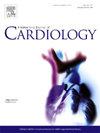A deep-learning system integrating electrocardiograms and laboratory indicators for diagnosing acute aortic dissection and acute myocardial infarction
IF 3.2
2区 医学
Q2 CARDIAC & CARDIOVASCULAR SYSTEMS
引用次数: 0
Abstract
Background
Acute Stanford Type A aortic dissection (AAD-type A) and acute myocardial infarction (AMI) present with similar symptoms but require distinct treatments. Efficient differentiation is critical due to limited access to radiological equipment in many primary healthcare. This study develops a multimodal deep learning model integrating electrocardiogram (ECG) signals and laboratory indicators to enhance diagnostic accuracy for AAD-type A and AMI.
Methods
We gathered ECG and laboratory data from 136 AAD-type A and 141 AMI patients at Zigong Fourth People's Hospital (January 2019 to December 2023) for training and validation. Utilizing ResNet-34 (residual network), we extracted ECG features and combined them with laboratory and demographic data. We assessed logistic regression, RandomForest, XGBoost, and LightGBM models, employing shapley additive explanations (SHAP) for feature importance analysis. Data from 30 AMI and 32 AAD-type A patients (January to September 2024) were used as a prospective test set.
Results
Incorporating ECG features significantly improved model's AUC value, with the RandomForest achieving the best performance (AUC 0.98 on validation, 0.969 on test). SHAP analysis revealed that troponin and D-dimer, along with the embedding features of ECG extracted by the deep neural network, are key characteristics for differentiating AAD-type A and AMI.
Conclusion
ECG features are valuable for distinguishing AAD-type A and AMI, offering a novel tool for rapid cardiovascular disease diagnosis through multimodal data fusion and deep learning.
求助全文
约1分钟内获得全文
求助全文
来源期刊

International journal of cardiology
医学-心血管系统
CiteScore
6.80
自引率
5.70%
发文量
758
审稿时长
44 days
期刊介绍:
The International Journal of Cardiology is devoted to cardiology in the broadest sense. Both basic research and clinical papers can be submitted. The journal serves the interest of both practicing clinicians and researchers.
In addition to original papers, we are launching a range of new manuscript types, including Consensus and Position Papers, Systematic Reviews, Meta-analyses, and Short communications. Case reports are no longer acceptable. Controversial techniques, issues on health policy and social medicine are discussed and serve as useful tools for encouraging debate.
 求助内容:
求助内容: 应助结果提醒方式:
应助结果提醒方式:


